How to make a pond with your own hands: 100 photos with instructions
Whether you like to swim or just relax near the water, relaxing on the shore of a reservoir is one of the great pleasures of summer. But not every summer resident has the opportunity to build a cottage near the water. Therefore, sooner or later, each of us thinks about how difficult it is to make a pond on the site with our own hands. Ideally, we see a pond in the country not only as a decorative element of landscape design, but also as a small body of water in which you can enjoy swimming on a hot day.
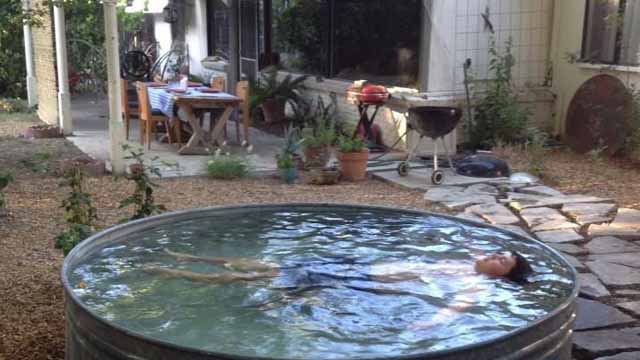 Let's start with the basics - what makes a pond fundamentally different from a pool is the self-regulation system.
Let's start with the basics - what makes a pond fundamentally different from a pool is the self-regulation system. 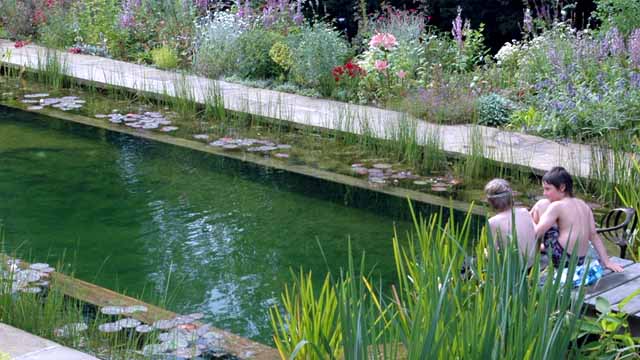
Bathing pond with their own hands.
We will tell you the process of creating a pond step by step, and you can make a garden pond with your own hands - by building a cool oasis in the middle of the heat right on your summer cottage, where our everyday worries disappear with every light breath of fresh breeze. 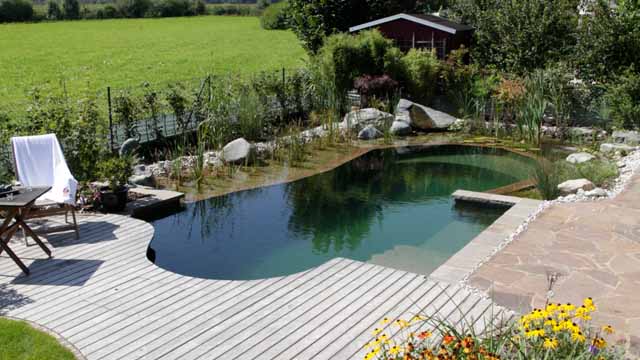
A garden pond is a living organism.
The pond in the country house mimics the process that nature uses to keep the lake clean. Everything - from the size and shape of the pond, plant species and water circulation are designed to maintain the pond in a stable natural state. 
The problems that the pond owner faces is maintaining the balance between plants and water - the plants either die or take over the entire surface of the pond. Only a pond that is a balanced ecosystem ensures optimal transparency and water quality, and maximum enjoyment of swimming in the pond. 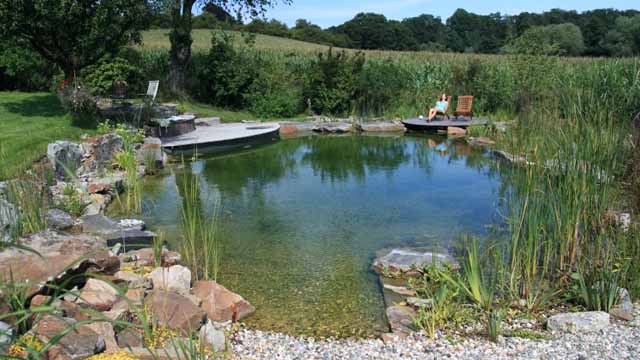
The water in the pond must circulate among the roots of the plants in order to be purified. Plants enrich the water with oxygen, which supports the vital activity of beneficial bacteria that utilize pollution and potentially harmful organisms, and also create a habitat for dragonflies, frogs and other aquatic life. The result is a stable, ecologically diverse system. Nature has revealed its technology to us and we must carefully use it.
How to make a pond yourself. The principles of the pond.
Water is a living biologically active component and all purification occurs due to the work of plants and beneficial microbes. To do this, the pond provides a bathing area and a filtration area for plants. The filtration zone is actually the swamp part of our water zone, and just like in nature, it is this one that guarantees the purity of the entire reservoir. This zone should occupy at least 50 percent of the total area of the water surface of the pond. 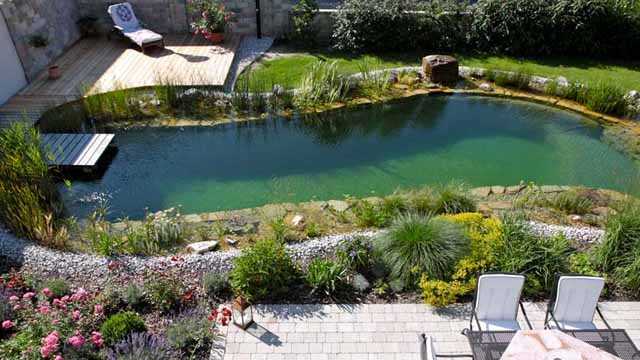 If you have noticed, then in nature there are almost no tiny reservoirs with a consistently clean surface of water - they quickly overgrow or silt. Natural stable biological balance can be achieved in ponds from 100 sq.m. Smaller ponds require more of our attention as they their biological balance is precarious. Therefore, these ponds include a skimmer and UV sterilizer to keep them clean, but still offer a chemical-free bathing area and support aquatic plant growth.
If you have noticed, then in nature there are almost no tiny reservoirs with a consistently clean surface of water - they quickly overgrow or silt. Natural stable biological balance can be achieved in ponds from 100 sq.m. Smaller ponds require more of our attention as they their biological balance is precarious. Therefore, these ponds include a skimmer and UV sterilizer to keep them clean, but still offer a chemical-free bathing area and support aquatic plant growth. 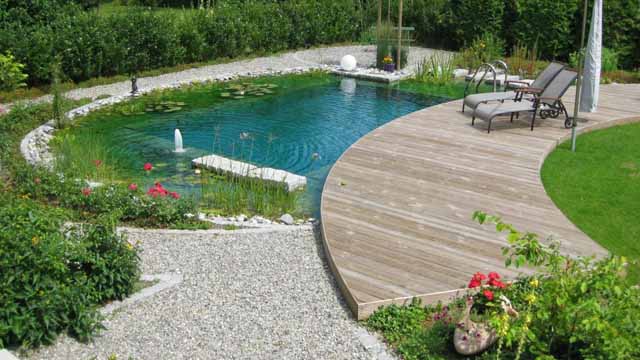
It is useful to add a small waterfall, stream or fountain to the pond for regular enrichment of water with oxygen. Although, for the same purpose, you can use an aerator.
How is pond water purified?
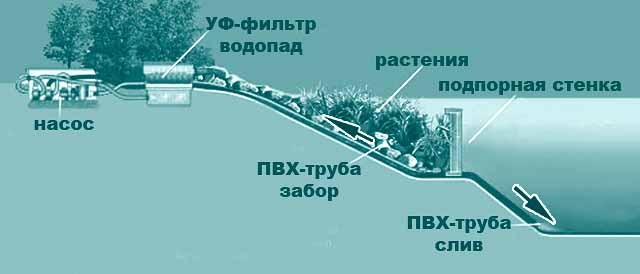 You can see that the process of filtering water in a pond is not complicated:
You can see that the process of filtering water in a pond is not complicated:
1. Water from the swimming area flows into the regeneration area.
2. Water circulates back to the bathing area.
Through the drainage pipes under the plant roots in the regeneration area or/and after the skimmer, the water is pumped through the UV sterilizer to the waterfall, stream or to the bottom of the swimming area. The pipe that goes to the bottom of the swimming area is slightly raised above the bottom so that the flow of water prevents the formation of silt at the bottom.
What should be the shape of the pond.
The bowl of the pond looks more like a soup bowl with large rims than a bathtub. The height difference should be about 30 cm for each meter of depth. It is this shape of the pond bowl that ensures the stability of the walls. The figure shows a cross section of a pond with a plant and bathing area:
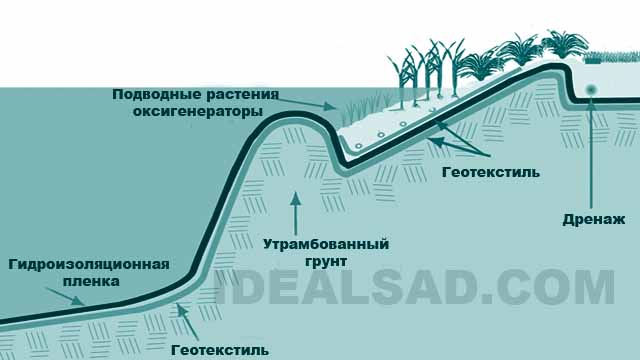
After compaction of the surface layer of soil in the pit, geotextiles and a hermetic liner are laid on the bottom of the pond. In the plant zone - drainage pipes and gravel. In order to separate the swimming zone from the plant zone, a small hillock is formed - its top is 3 cm lower from the water surface. It can be made from sandbags or gravel. The mound allows water from the swimming area to pass into the plant area, where the water is filtered by the plant roots, and at the same time protects the plants from fluctuations in the water of the swimming area. 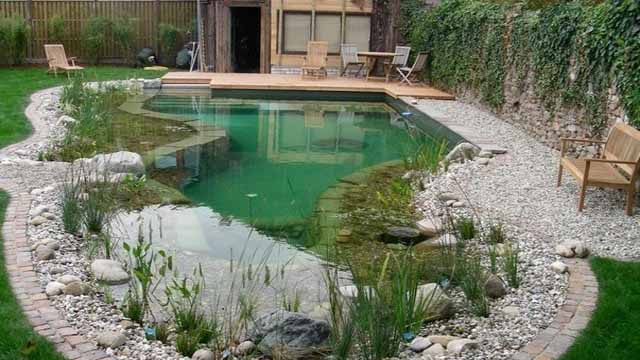
This design of the pond will allow you to conveniently clean the swimming area without affecting the plant area. In addition to purifying the water, the shallow water warms up quickly and serves as a habitat for frogs and other invertebrates, you will appreciate their benefits when they start eating mosquito larvae. 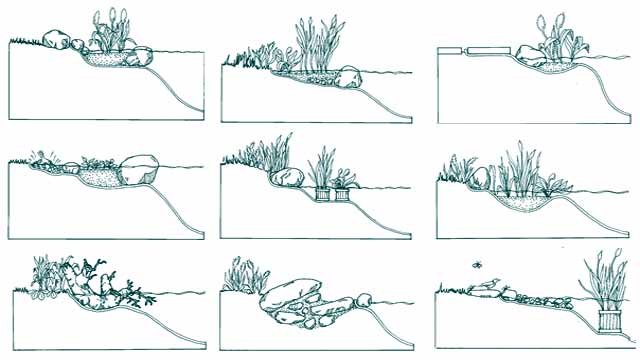 In order to mimic the natural contours of a pond, use a combination of different profiles for its shore. If you have plants on pond terraces, it is better to do this in pots so that they can be easily removed when cleaning the pond.
In order to mimic the natural contours of a pond, use a combination of different profiles for its shore. If you have plants on pond terraces, it is better to do this in pots so that they can be easily removed when cleaning the pond.
What size pond is suitable for our site?
The optimal size of the pond is 1/10 of the area of your site.
How about mosquitoes?
One of the first questions that arises at the word “pond with your own hands” is mosquitoes? Mosquitoes breed only in stagnant water, while the water in the pond will never be static, so mosquitoes will find it unattractive for their habitat. Even if at some point they appear, the frog pond ecosystem will reduce their population to a minimum. 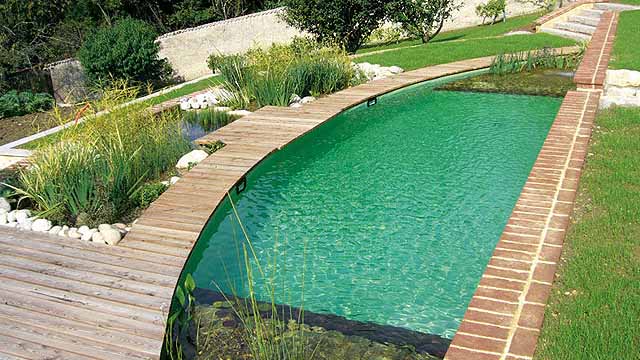
Why make a pond in the country?
Do-it-yourself pond people make this decision because they want to see their pond as a beautiful part of the landscape design and still have a clean, inviting place to swim on a hot day.
Is it possible to have fish in the swimming pond?
Unfortunately, fish, on the one hand, eats beneficial microflora with pleasure, on the other hand, it is a carrier of pathogenic bacteria, so there should not be fish in the baths. 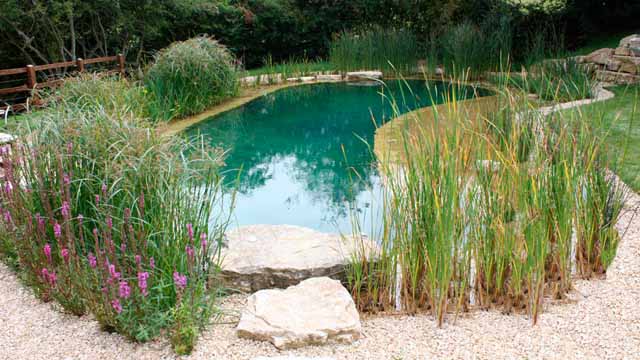
Is it possible to make a sandy beach on a pond?
The best solution for entering the pond is walkways or stairs. For a beach entrance to the water, you need enough space, because. the angle of entry into the water is small. In addition, the sand quickly silts up - those beaches that we see are often simply trampled down to sand, most of the pond shore is usually densely overgrown with plants. 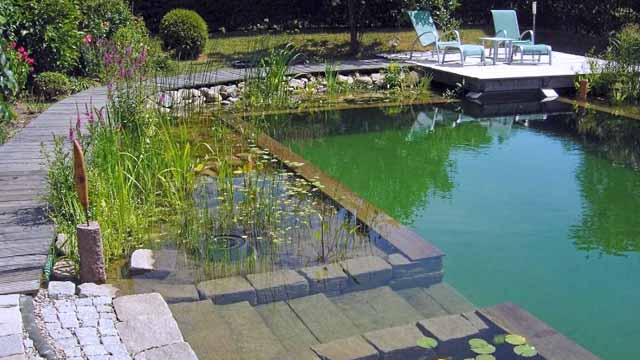
Should I swim with frogs?
Yes, frogs are full-fledged and important inhabitants of the pond. Additionally, to purify the water in the pond, it is good to have double-winged toothless shells or barley, which filter water up to 40 liters per day. You can also get snails (coils, livebearers) - they eat dead plants and clean the pond well. 
What is the best place for a pond?
It is better to place the pond away from the trees, because. falling, the leaves will rot in the pond. Moreover, growing roots can damage the waterproofing film or tilt the finished container. The illumination of the site should be about 5 hours in the morning, and the rest of the time it should be in partial shade. The pond does not need large illumination. leads to increased formation of algae and overheating of water in the reservoir. 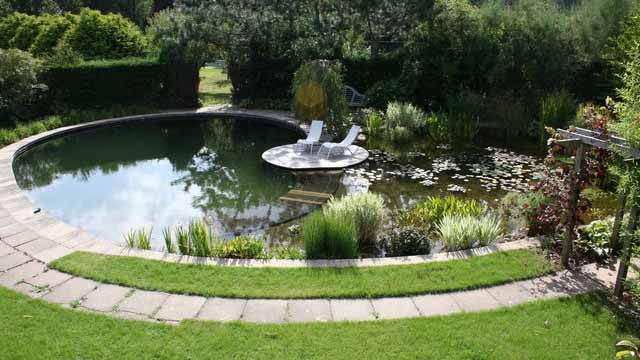
What to do with the pond in winter?
In winter, the pond, like natural reservoirs, freezes. You don't need to drain it. For the winter it is necessary to remove all equipment from the pond (pumps, filters, skimmers).
Does the type of soil affect the creation of a pond?
No, the composition of the soil does not affect. There is a misconception that it is good when the groundwater level is high. In fact, groundwater at the freezing level is more of a problem. Freezing, the ice can bulge the bottom of the pond. It is especially problematic if the pond is made on the basis of a rigid finished form. 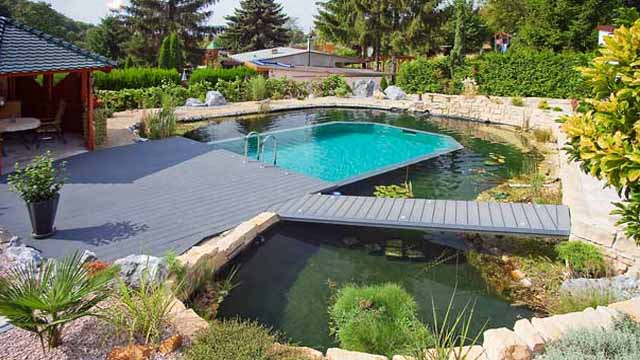
Do-it-yourself pond from a film.
The main question when creating a pond: how to make it waterproof. There are several types of pond waterproofing - film, clay castle, concrete and rigid installation.
Rigid mold installation is a simple and durable method, but they usually come in small sizes up to 3.5 square meters. meters. Their service life is 10-50 years.
Waterproofing with concrete is the most expensive, in addition, it needs additional treatment with a frost-resistant agent and liquid glass to protect it from frost.
A clay castle is the cheapest in terms of materials, but the most labor-intensive. In order to waterproof the pit with clay, the compacted soil is covered with wood ash or soot. Then a 15 cm layer of clay dough is applied to the walls, compacted. When the layer dries, a second 30 cm is applied. When the layer is almost dry, crushed stone is poured on it, slightly pressing into the layer.
The optimal solution for the construction of ponds with an area of more than 5-6 sq.m. - film waterproofing. 
How much film is needed for the pond:
Film length= length of the pond + 2 • depth of the pond + 50 cm margin for fasteners.
Film width= width of the pond + 2 • depth of the pond + 50 cm margin for fasteners.
The film is produced in widths from 2 to 10 m, length 10-50 m. Knowing your needs, you can choose the optimal roll. The film is bought before digging the pit, this will allow you to cover it immediately when the pit is ready, preventing its edges from shedding.
What kind of film to choose for the pond.
PVC film for a pond is cheaper, but eventually destroyed by ultraviolet radiation, its service life is 8-10 years.
Butyl rubber sheeting is more expensive, but has both UV and cold protection. The service life of such a film is 50 years.
Do-it-yourself pond construction photo.
Do-it-yourself pond begins with marking the pit. The curved shape can be marked with a hose. We remove the sod along the coastline and take out the soil on the bayonet - this will be the line of the swamp zone, then the next level of the earth is taken out inside the resulting border, and so on. As a result, our terraces will be 50 cm wide with slopes of 20 cm. When the pond pit is ready, all hard objects that can damage the film: stones, roots, etc. , remove. We level and ram the walls and bottom of the pit. 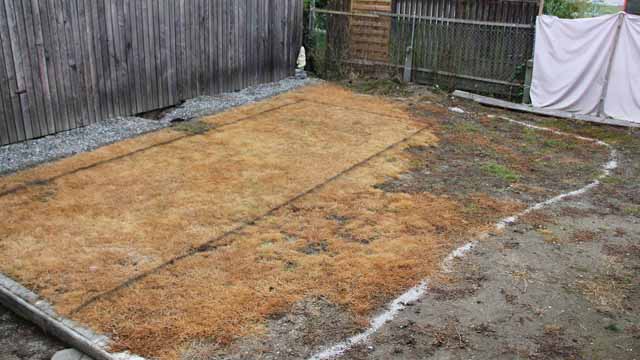 Before work, the film is laid for several hours in a sunny place so that it warms up and becomes more elastic. Laying the film is done in warm weather. Overlapped geotextile or felt sheets are laid on the compacted pit, they are needed to protect the waterproofing film from protruding roots and stones over time.
Before work, the film is laid for several hours in a sunny place so that it warms up and becomes more elastic. Laying the film is done in warm weather. Overlapped geotextile or felt sheets are laid on the compacted pit, they are needed to protect the waterproofing film from protruding roots and stones over time. 
A waterproofing film is spread on top of the geotextile with a margin of 50 cm along the edges of the pit. The edges are temporarily fixed with stones. The film is allowed to sag a little, smoothing and leveling it according to the shape of the pit. 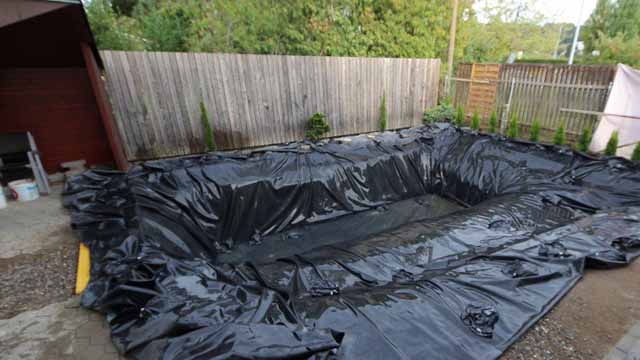
The foil inside the swimming area can be protected with dry stacked stones.
When the pond is completely filled with water, the ends of the film are securely fixed in a trench, which is made at a distance of 15 cm from the edge of the pit. In a trench 20 cm deep, the edges of the film are wrapped in a roll and covered with stones and pebbles.
We make a pond with our own hands. Shore decoration.
After you have made a pond with your own hands, before you start decorating the shore, you need to pour plenty of water on it and wait 2-3 days, because. shrinkage is possible. In addition, during this time, the water in the pond will settle.
We mask the film on the shore with rubble, stones, snags. We plant plants in shallow water. The pond needs plants that saturate the water with oxygen. There are many suitable plants - reeds, meadowsweet, iris, bathing suit, marigold, arrowhead. Any plant that grows on the shore of a natural pond will work for your pond. Don't forget about algae, like hornwort, which just floats in the water. Deciduous ornamental shrubs are best planted behind marsh grasses, which are planted directly on the shore.
Pond safety.
If there are very young children in the family, then perhaps the construction of the pond should be postponed until they are older. It is necessary to consider visiting the pond by the elderly and school-age children. Make a convenient ladder for entering the pond, don't forget to clean it so it doesn't get slippery! All other sides of the pond, except for the entrance, are best covered with plants. 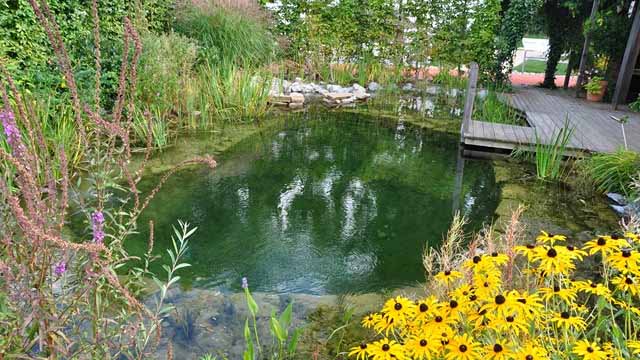
Pond care.
The new pond will take on its natural form throughout the year - while it will form its ecosystem. The small world of your pond is very vulnerable. The pond may quickly heat up or freeze, the water may evaporate, or the pond may overflow after rain. This puts a strain on aquatic life that cannot instantly transition to a safer, more stable environment. 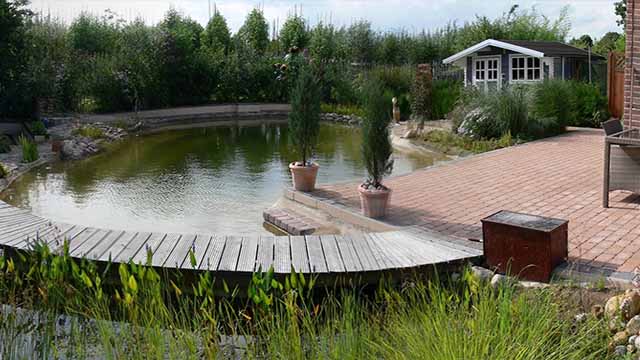
Therefore, your pond, like any living organism, requires care. On a hot day, you need to add water, collect garbage that floats on the surface with a net, check whether the plants have grown or perhaps something has not taken root and must be annoyed. However, a surprising number of life forms will colonize your new pond, they will quickly explore new waters and stay if conditions suit them. 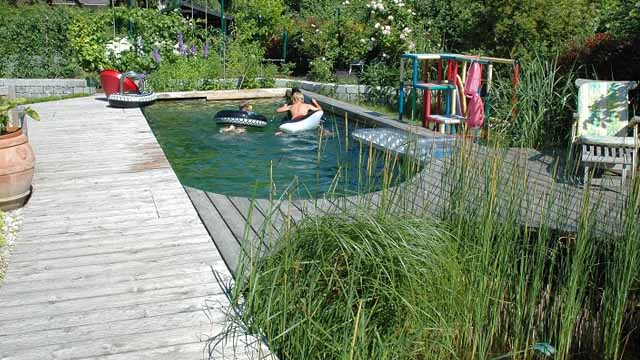
The quiet splash of water is the most enchanting melody of a hot summer, water bewitches, attracts and seduces us with a playful play of light, transparent depth and life-giving coolness. A handmade pond will give your cottage a special charm.
 Masonry mortars for brick kilns
Masonry mortars for brick kilns Why do the windows fog up in the apartment
Why do the windows fog up in the apartment Construction and schemes of brick ovens
Construction and schemes of brick ovens How to lay paving slabs: tips and tricks
How to lay paving slabs: tips and tricks How to drill bathroom tiles
How to drill bathroom tiles Monolithic slab on coarse soil
Monolithic slab on coarse soil Which electric heater is economical
Which electric heater is economical